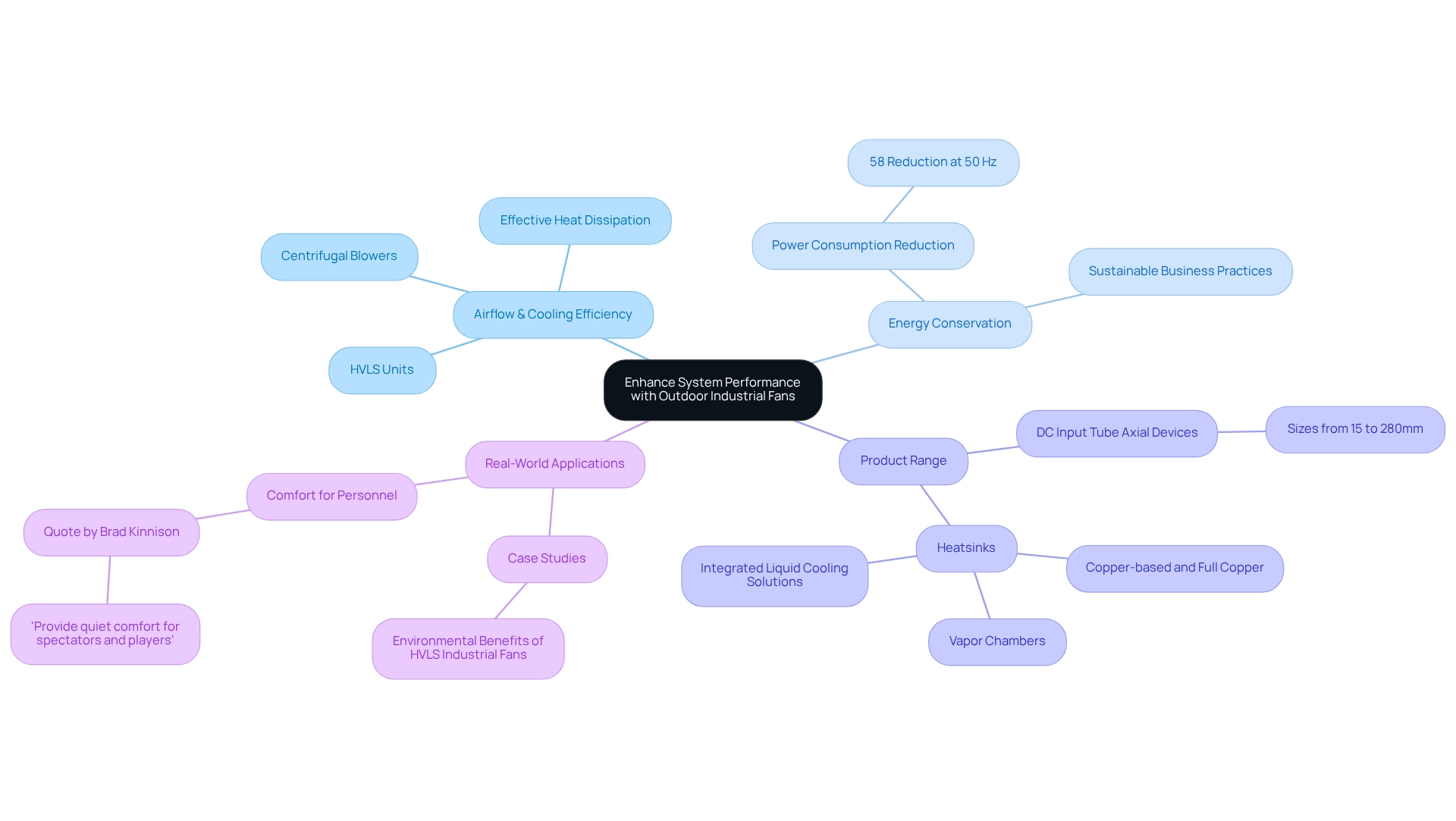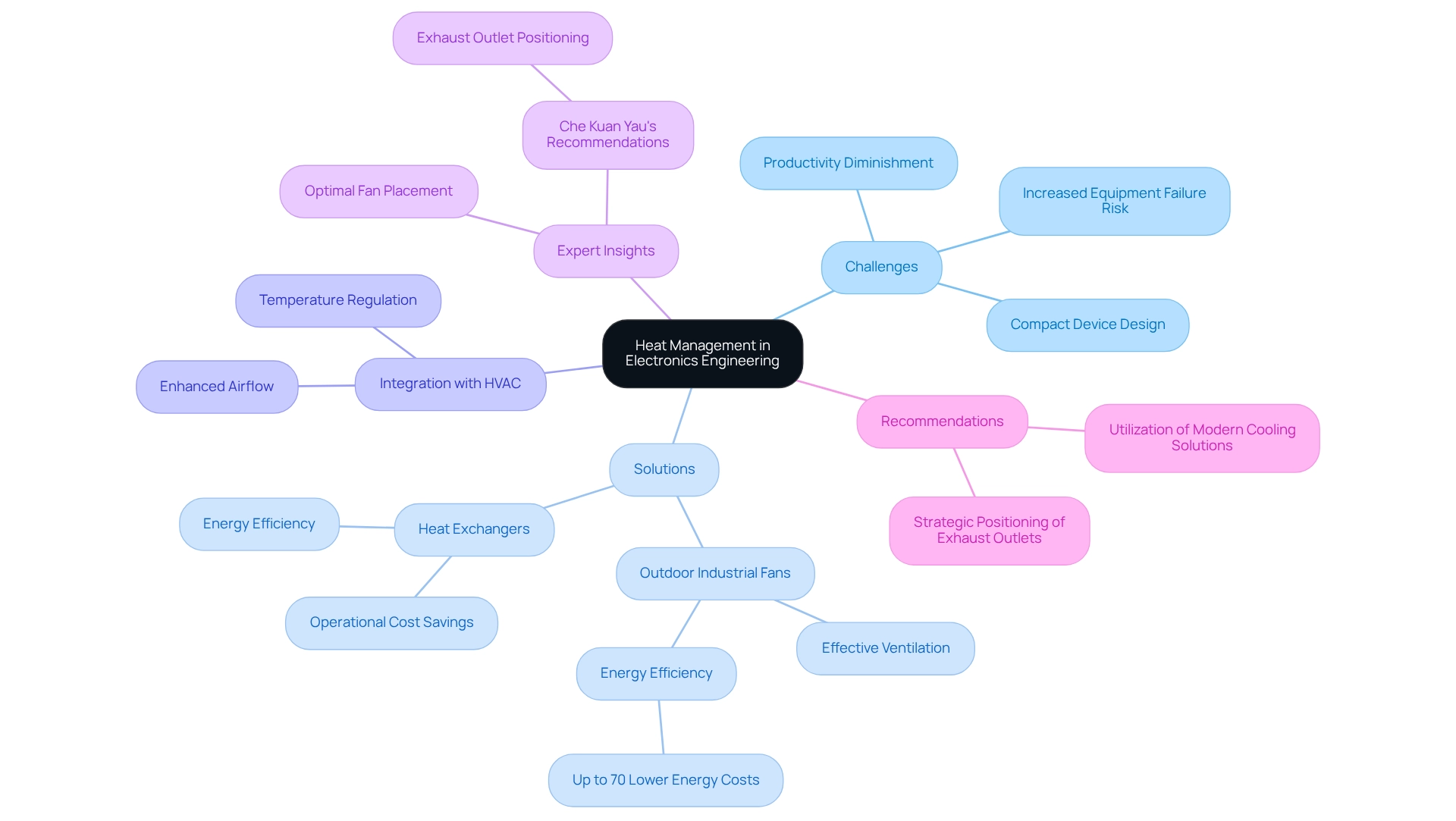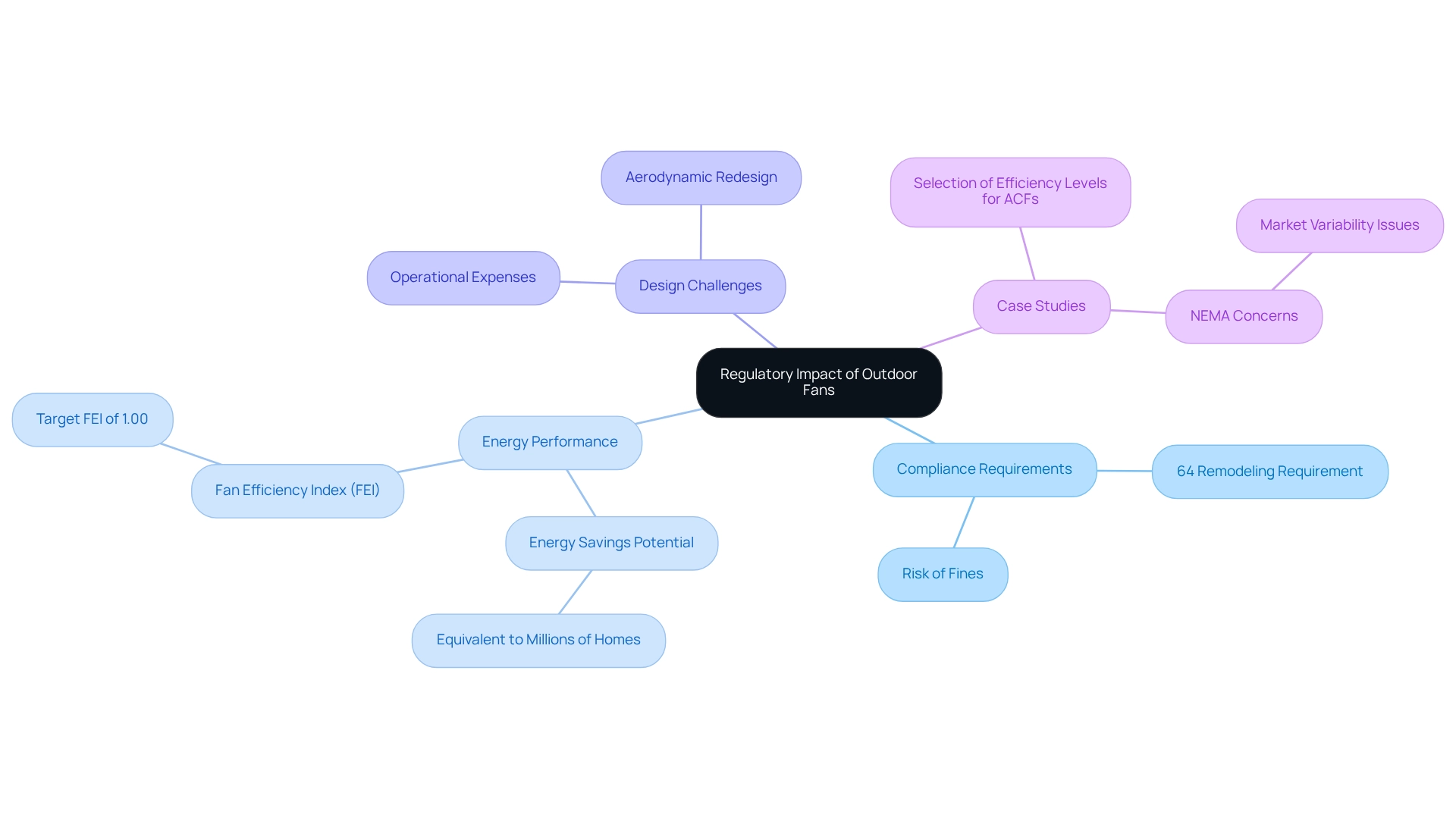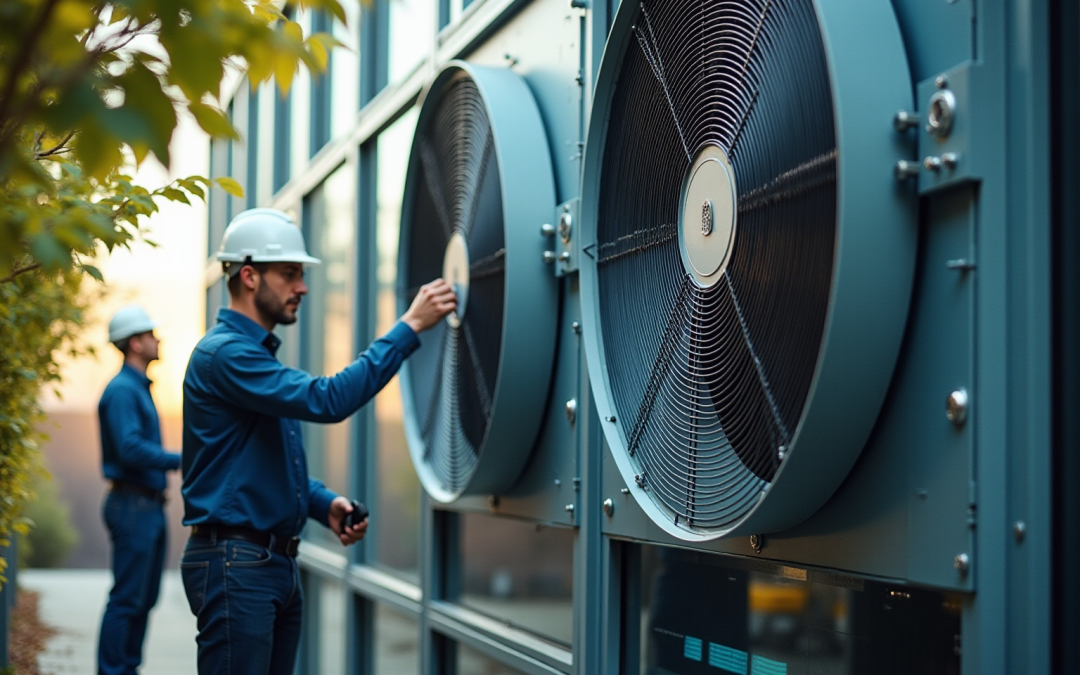Overview
Outdoor industrial fans play a pivotal role for electronics engineers, optimizing system performance by enhancing airflow and cooling efficiency. This is particularly crucial in environments where electronic components generate significant heat. These fans not only improve thermal management but also reduce energy consumption and ensure compliance with regulatory standards. The outcome is a substantial contribution to lower operational costs and a more sustainable working environment.
Introduction
In the pursuit of optimal performance within electronic systems, outdoor industrial fans stand out as an essential solution, effectively addressing the critical demand for cooling and airflow management. As electronic devices continue to shrink in size while increasing in power, the challenge of heat management escalates, particularly in environments such as data centers and manufacturing facilities where excessive heat can impede efficiency and precipitate equipment failure.
By adopting advanced fan technologies, including those provided by Gagner-Toomey Associates, engineers not only enhance thermal management but also realize substantial energy savings and sustainability objectives. This article explores the multifaceted advantages of outdoor industrial fans, examining their contribution to improved system performance, their role in overcoming engineering challenges, and their importance in ensuring compliance with evolving regulatory standards.
Enhance System Performance with Outdoor Industrial Fans
Outdoor industrial blowers play a critical role in optimizing the performance of electronic systems by significantly enhancing airflow and cooling efficiency. In environments where electronic components generate substantial heat—such as data centers and manufacturing facilities—maintaining optimal temperatures is essential. , the world’s largest producer of standard and custom air-movers, offers a diverse range of DC input tube axial devices, available in sizes from 15 to 280mm, as well as centrifugal blowers, ranging from 15 to 225mm. These products are specifically designed to promote and prevent overheating, ensuring that electronic systems operate within their specified temperature ranges.
For instance, high-volume, low-speed (HVLS) units from Gagner-Toomey are engineered to circulate substantial amounts of air at reduced speeds, producing a gentle breeze that cools machinery without causing disruptive airflow. This feature is particularly advantageous in large-scale settings where may prove inadequate.
Incorporating into system designs not only but also contributes to . Statistics reveal that . This efficiency translates into lower operational costs and a diminished carbon footprint, aligning with sustainable business practices. By reducing energy usage, engineers can achieve significant operational cost reductions, further underscoring the importance of these devices.
Real-world applications underscore the effectiveness of outdoor industrial fans in data centers. Case studies demonstrate that the implementation of leads to improved airflow, which is vital for maintaining the efficiency of electronic systems. Engineers have noted that these devices provide quiet comfort, enhancing the working atmosphere for both personnel and equipment. As Brad Kinnison states, ‘Offer peaceful relief for spectators and players with HVLS external large-volume air circulators.’ This perspective highlights the benefits of these devices in terms of both performance and comfort.
Moreover, Gagner-Toomey’s outdoor industrial fan ventilation systems can be tailored for specific commercial areas that prioritize style and durability, broadening their appeal beyond mere functionality. Insights from the case study titled “Environmental Benefits of ” emphasize their role in promoting sustainable business operations, showcasing energy efficiency and a reduced carbon footprint.
In addition to cooling solutions, Gagner-Toomey provides an extensive array of products, including:
- Extruded aluminum heatsinks
- Copper-based and full copper heat sinks
- Heat sinks with embedded heat pipes
- Vapor chambers
- Cold plates
- Integrated liquid cooling solutions
By prioritizing external mechanical ventilators in their designs, engineers can achieve enhanced thermal regulation, ultimately prolonging the durability and reliability of electronic components. In conclusion, outdoor industrial fans not only enhance cooling performance and energy conservation but also contribute to a more comfortable and sustainable workplace.

Address Engineering Challenges: Heat Management and System Integration
presents a formidable challenge for , particularly as devices become increasingly compact and powerful. are essential in addressing these challenges by providing effective ventilation and . In manufacturing environments where multiple machines operate simultaneously, the heat generated can significantly diminish productivity and increase the risk of equipment failure. By , engineers can establish a balanced thermal environment that facilitates the removal of hot air while introducing cooler air. Furthermore, these devices can be seamlessly integrated with existing HVAC systems, enhancing overall airflow and temperature regulation. This integration not only improves system performance but also promotes energy efficiency, potentially reducing energy costs by as much as 70%.
For instance, , such as , exemplify advancements in cabinet cooling technology. While they may incur higher installation costs, they operate only when necessary, leading to and improved cooling efficiency.
Expert insights underscore the effectiveness of in manufacturing settings. Industry leaders recommend optimal fan placement, advocating for the strategic positioning of exhaust outlets to maximize airflow. As Che Kuan Yau noted, positioning the exhaust outlet on the highest sides or back rather than the top is a prudent suggestion. By addressing heat management challenges with innovative ventilation strategies, the use of an outdoor industrial fan significantly reduces equipment failure rates and enhances operational reliability in the electronics sector. Gagner-Toomey Associates’ further establishes them as a knowledgeable resource for implementing these effective solutions.

Ensure Compliance and Efficiency: The Regulatory Impact of Outdoor Fans
The regulatory landscape for is becoming increasingly rigorous, influenced by standards set by the Department of Energy (DOE) and the California Energy Commission (CEC). These regulations impose that significantly affect the design and operational expenses of electronic systems. Adhering to these standards not only fosters but also improves , leading to significant cost savings over time.
For instance, models that meet or surpass these performance benchmarks can result in comparable to the yearly energy use of millions of households, especially vital in large-scale operations where energy costs are significant. Engineers must remain vigilant regarding these regulations to ensure their designs are compliant, thereby mitigating the risk of fines and extending the lifespan of their systems.
Notably, models representing 64 percent of all ACF shipments will need to be remodeled in the 5-year compliance period, highlighting the scale of and engineers. The DOE’s recent analysis on airflow effectiveness levels for axial fans highlights a shift towards a Fan Efficiency Index (FEI) of 1.00, which is expected to be feasible for manufacturers.
Moreover, case studies suggest that a blend of performance-level and design-option strategies has facilitated a more comprehensive understanding of baseline and aerodynamic redesign performance levels, addressing gaps for intermediate performance levels. This thorough examination highlights the importance for engineers to incorporate these standards into their , ensuring both compliance and operational effectiveness.
As NEMA has indicated, there are worries about implementing a market such as DPPP, which has a specific purpose and sees less variety of designs and producers, to the significantly more varied market of blowers and ventilation devices. Therefore, it is crucial for engineers to navigate these complexities effectively.
In summary, understanding and adhering to these is essential for optimizing the design and operational efficiency of .

Conclusion
The integration of outdoor industrial fans into electronic systems provides a multifaceted solution to the pressing challenges of heat management and energy efficiency. By enhancing airflow and cooling capabilities, these fans play a pivotal role in maintaining optimal operating temperatures in high-heat environments such as data centers and manufacturing facilities. Gagner-Toomey Associates exemplifies innovation in this realm, offering a range of advanced fan technologies that not only improve system performance but also contribute to significant energy savings and sustainability goals.
Furthermore, the strategic placement and integration of outdoor industrial fans with existing systems can lead to remarkable reductions in energy costs, underscoring their significance in modern engineering practices. As devices become increasingly compact and powerful, the necessity for effective ventilation intensifies, preventing equipment failure and ensuring operational reliability. By adopting these solutions, engineers can establish a balanced thermal environment that supports the longevity of electronic components.
Lastly, compliance with evolving regulatory standards highlights the importance for engineers to prioritize efficiency in their designs. Understanding these regulations mitigates risks while promoting environmental sustainability. As the industry adapts to these challenges, outdoor industrial fans emerge as an indispensable component in the pursuit of optimal performance, energy efficiency, and regulatory compliance in electronic systems. Embracing these advancements not only enhances operational effectiveness but also positions businesses as leaders in sustainable practices.
Frequently Asked Questions
What is the role of outdoor industrial blowers in electronic systems?
Outdoor industrial blowers optimize the performance of electronic systems by enhancing airflow and cooling efficiency, which is essential in environments where electronic components generate substantial heat.
What types of products does Gagner-Toomey Associates offer for cooling?
Gagner-Toomey Associates offers a range of DC input tube axial devices in sizes from 15 to 280mm and centrifugal blowers ranging from 15 to 225mm, designed to promote effective heat dissipation and prevent overheating.
How do high-volume, low-speed (HVLS) units function in cooling applications?
HVLS units circulate large amounts of air at reduced speeds, producing a gentle breeze that cools machinery without causing disruptive airflow, making them particularly effective in large-scale settings.
What are the energy conservation benefits of using outdoor industrial fans?
Using outdoor industrial fans can decrease power consumption by up to 58% at 50 Hz when fan speeds are reduced with pulse-width modulation (PWM) control, leading to lower operational costs and a reduced carbon footprint.
How do outdoor industrial fans improve the working atmosphere in data centers?
The implementation of HVLS units in data centers improves airflow, which is vital for the efficiency of electronic systems, while also providing quiet comfort for personnel and equipment.
What other products does Gagner-Toomey provide besides outdoor industrial fans?
Gagner-Toomey offers a variety of products including extruded aluminum heatsinks, copper-based and full copper heat sinks, heat sinks with embedded heat pipes, vapor chambers, cold plates, and integrated liquid cooling solutions.
How do outdoor industrial fans contribute to sustainability in business operations?
Outdoor industrial fans promote energy efficiency and a reduced carbon footprint, which aligns with sustainable business practices and enhances thermal regulation, prolonging the durability and reliability of electronic components.

